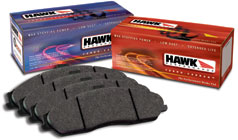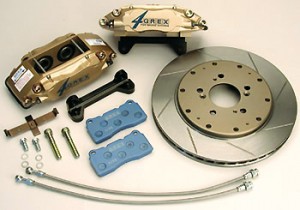Hammer time! You knew that was coming…..
Seriously though, something we always stress to our customers is that your car can have all the power in the world but will just end up being a hazard to you and others if you can’t stop.
Some of the simplest things we can do to increase our braking power and decrease out stopping distance is with a good set of brake pads and rotors. When it comes to brake pads, there are a number of choices we can recommend to our customers depending on the type of car they have and how it will be driven. It is important to know that aftermarket performance brakes like many other aftermarket items have trade offs. When it comes to aftermarket brake pads you may have to live with more noise, shorter pad life or increased brake dust in order to gain better stopping power. However, these days with better brake technology, many of our customers barely notice a difference when it comes to noise, pad life and brake dust with many of todays high performance street pads but see a noticeable improvement in stopping power.
When it comes to brake pads, there are a number of choices we can recommend to our customers depending on the type of car they have and how it will be driven. It is important to know that aftermarket performance brakes like many other aftermarket items have trade offs. When it comes to aftermarket brake pads you may have to live with more noise, shorter pad life or increased brake dust in order to gain better stopping power. However, these days with better brake technology, many of our customers barely notice a difference when it comes to noise, pad life and brake dust with many of todays high performance street pads but see a noticeable improvement in stopping power.
When it comes to rotors, there is a lot of talk about which is better: Slotted or Crossdrilled or rotors with both? First off something needs to be cleared up, no matter what process is used or who makes them, rotors that are crossdrilled, slotted or both are more prone to cracking and warping than plain full faced rotors. When ever you are taking away the rotor’s structural integrity by drilling holes or cutting slots into it you are weakening it, now add high temperatures to the mix and the formula for damaging rotors is complete. With that being said, for cars that are used on the street and track for lapping days it is very very rare that aftermarket crossdrilled or slotted rotors will ever fail you. Brakes are not as complicated as some people make them out to be, you car stops by friction. The brake pad gets pushed against the rotor which causes friction which slows the car down and eventually stops it. The byproduct of heat is the enemy.
First off something needs to be cleared up, no matter what process is used or who makes them, rotors that are crossdrilled, slotted or both are more prone to cracking and warping than plain full faced rotors. When ever you are taking away the rotor’s structural integrity by drilling holes or cutting slots into it you are weakening it, now add high temperatures to the mix and the formula for damaging rotors is complete. With that being said, for cars that are used on the street and track for lapping days it is very very rare that aftermarket crossdrilled or slotted rotors will ever fail you. Brakes are not as complicated as some people make them out to be, you car stops by friction. The brake pad gets pushed against the rotor which causes friction which slows the car down and eventually stops it. The byproduct of heat is the enemy.
Here is a good article on the the pros and cons of different rotors. Link
Now you might be asking if these rotors are weaker than full faced rotors, why are they used in racing? These days a lot of automotive teams have moved to Carbon Ceramic pads and discs which are more at home at higher brake temperature, Porsche was one of the first to start offering Ceramic brakes on their street cars for those who demand more stopping power on the street and for the occasional lapping day at the track, at the tune of $10K+ per pad and rotor change……….. For other classes of race cars and series where teams are still using metal pads and rotors, different areas are upgraded to assist in the cooling of the braking system to help prevent warping and cracking. Most notable would be the front aerodynamics built into a race cars bumper. Millions are spent every year by race teams to design the cars body pieces in order to not only prevent lift but to assist with braking.
Now you might be asking if it is all worth it. Yes! What we have found from years and years of being in the business is that warping and cracking of rotors is rare for our customers who regularly drive their cars on the street and who are avid participants at lapping days and autocross events.
Contact us and ask us about Xtremestop Rotors and Hawk Performance Brake Pads. For those looking for something more for their race cars and street cars, ask us about our big brake kits!
